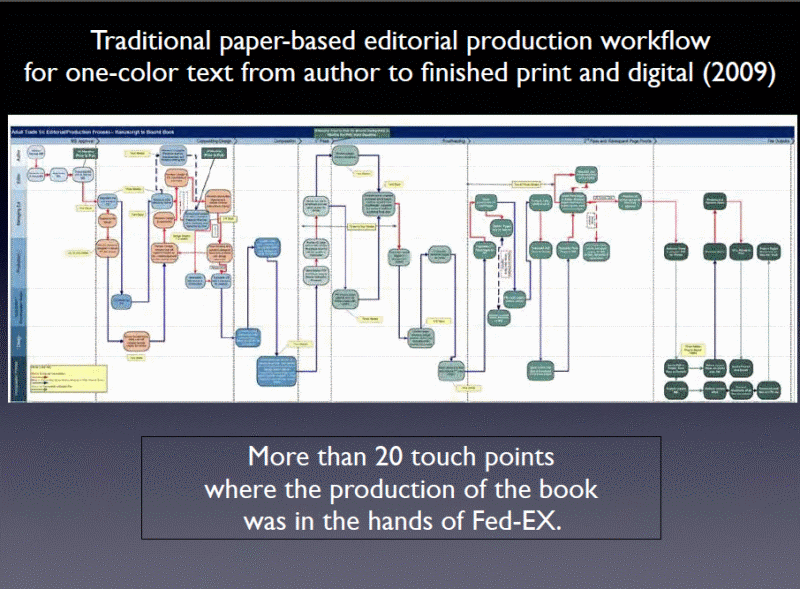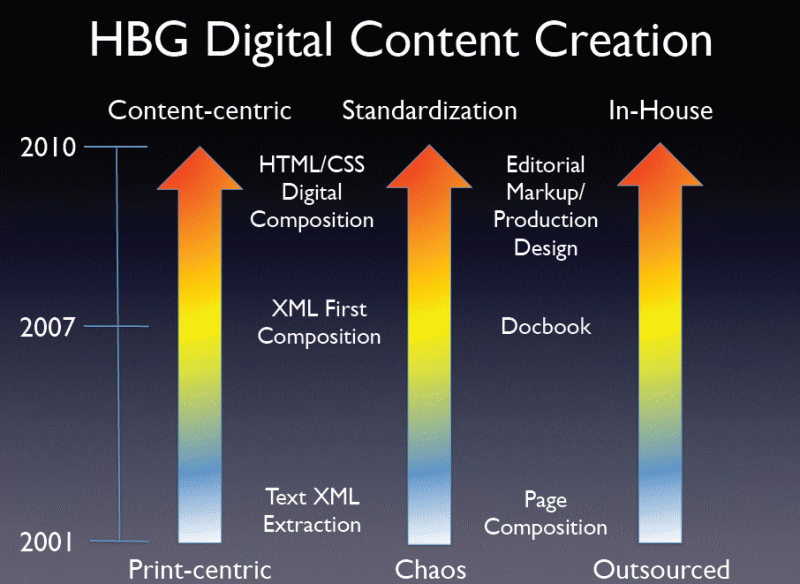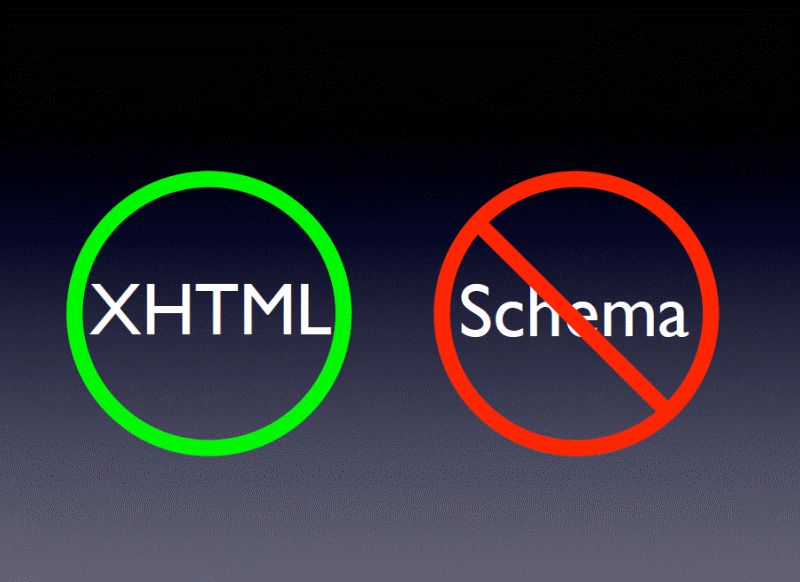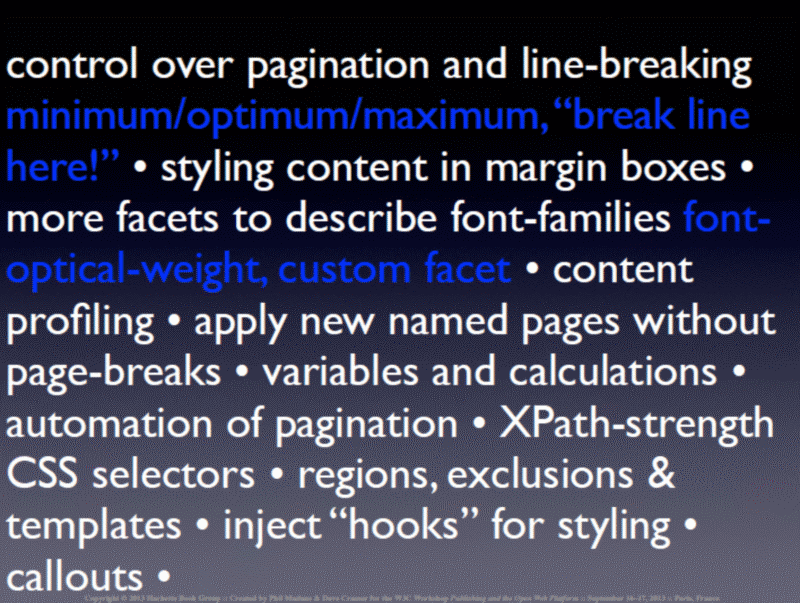#OWPWorkflow Publishing and
the Open Web Platform
21 September 2013
The W3C recently held a conference Publishing and the Open Web Platform. Following a conference on Twitter is probably not quite the same as being there.
The W3C recently held a conference Publishing and the Open Web Platform. Following a conference on Twitter is probably not quite the same as being there, but here are our impressions of what went on in this potentially important first meeting.
The Conference Objectives:
The goal of this W3C Workshop is to bring together major players, including publishers, standardization organizations, technology developers, booksellers, accessibility organizations and others as needed to identify areas where work is needed to make the Open Web Platform suitable for commercial publishing, especially in print, all the way from authoring through to delivering the printed product and beyond.
We have been working in the XHTML(5)/CSS space for well over five years now. IGP:Digital Publisher uses PrinceXML for the production of print books from XHTML5 (specifically IGP:FoundationXHTML). This conference was of significant interest, especially because HBG was there and presenting.
HBG's #OWPWorkflow Presentation
HBG use IGP:Digital Publisher under the in-house avatar DANTE. A not so subtle reference to Dante Alighieri's epic poem The Divine Comedy and the hero's epic journey through Hell, Purgatory and Heaven.
Depending on the editor/book requirements-du-jour the production of books using IGP:Digital Publisher hover between Hell and Purgatory. But every now-and-then a glimpse of multi-format production heaven can be glimpsed through the CSS clouds.
Opening Day 2 of the conference started with a bang with the HBG presentation "The Exotic World of Trade Publishing" in two parts. (Access PDF here).
Part One:Culture and Workflow by Phil Madans (LinkedIn Profile) and...
Part Two: The Books by Dave Cramer (LinkedIn Profile).
These guys have more real-world XHTML multi-format publishing experience between them than probably anyone else on this lovely planet.
Part One: Culture and Workflow
Phil highlights the changes HBG has been through and the effects of those changes on the way the company production operates.
It would have been far easier to go from typesetting with hot metal directly to HTML +CSS... We couldn't change fonts after typesetting... every change used to be expensive, yet with desktop publishing changes became cheap, and now there are more cycles...but with CSS we are going back to having changes being harder again... but yet are now used to much change
Phil Madans (From Draft Minutes)
Phil's big picture culture change was highlighted by two dramatic slides:

The old workflow. The awesomeness of this workflow chart resulted in multiple tweets.

How HTML/CSS workflow has empowered operational changes. A decade long transition from print-centric to Content-centric; Chaos to Standardization; Outsourced to Inhouse.
It's clear to see that stepping up to the HTML5/CSS3 plate has significant advantages for any publisher with virtually any type of content.
Part Two: The Books
Dave highlighted the attention to detail that has to be part of every publisher's production effort. He was particularly targeting how a lack of CSS properties tends to make what should be easy harder. PrinceXML has addressed some of these issues.
Notably with an excellent HTML selector grammar and tagging patterns the HTML part is virtually invisible. It's the CSS front and center.
This notable quote from the presentation sums up many of the challenges publishers will face with their change management from WYSIWYG to WYSIWYM (What You See Is What You Mean).
"As Phil mentioned, most of our staff expects that anything, no matter how small, can be easily changed. A generation of WYSIWYG desktop publishing spoiled them, and outsourcing isolated them from the consequences."
Dave Cramer
Possibly the most important slide in the presentation capturing pretty much everything that is being discussed.

HTML works so well for our markup that we don’t even have to think about it. Using multiple class attributes as needed makes everything possible. We do NOT have a schema. We define "tagging patterns" which are user-extensible as needed. Note the "X" is important...
And finally the CSS extension wishlist to make things easy.

It hardly matters if something is possible. What matters is that it’s easy. Each of our production designers is working on hundreds of books in a year. Every day I get questions about running heads, or footnotes, or why that damned line won't break where it's supposed to.
So my wish-list gets longer every day.
The mental changes have to be made. In our experience smaller publishers, academic and textbook publishers have fewer change-management challenges than general trade-publishers.
While some detail aspects of print books are more challenging with an XHTML5/CSS strategy, many are easier.
The business power advantages of the system which reduce total production and content ownership costs are:
- Once content source, many print and eBook formats.
- The content is always available and always trustworthy.
- Many people can work on a book at the same time, even with different workflow roles.
- Digitize Once. Use Forever.
And In Conclusion
Thanks to @CorbasLtd and @TAC_NISO for their relentless #OWPWorkflow tweets to ensure those concerned and interested got a feel for the conference.
The tweets faltered in the day two afternoon general conversations but the un-edited draft minutes of the conference are available here for the 16th September 2013 and 17th September 2013. These certainly give a good summary picture of what was being discussed.
What next? It now remains to be seen how this is taken forward. While the conversation was a little wider than just print production using CSS, from what I understand from Daniel Glazman's @glazou comments the recommendations have to be submitted to the CSS working group.
Here at Infogrid Pacific we like to describe ourselves as (early) practioners rather than theorists or specifiers. We watch and wait.
The HTML5/CSS2/3 Rendering Engines
Of course the core requirement to use HTML5/CSS for print is to have compliant and reliable rendering engines. That's the hard part with all this stuff. The big three rendering engines in this area are:
PrinceXML. This has always been CSS and hasn't had a toe in the murky XSL-FO waters. This is our solution of choice since 2006. It's fast, small and flexible. The latest Version 9 includes support for HTML5 and Javascript. It is light on MathML and SVG but constantly getting better. Price starts at US$3,800.
Antenna House XSL Formatter. This also supports XHTML/CSS rendering. We first used the XSL-FO versions back in 2002 when it was the only real game in town. It does MathML and SVG rendering well which may be a reason to select this option. Price starts at US$5,000.
RenderX XEP Engine. We haven't looked at this since the beginning of this century but it doesn't appear to support HTML/CSS rendering. Please correct me if I am wrong. Price starts at US$4,750.
Posted by Richard Pipe